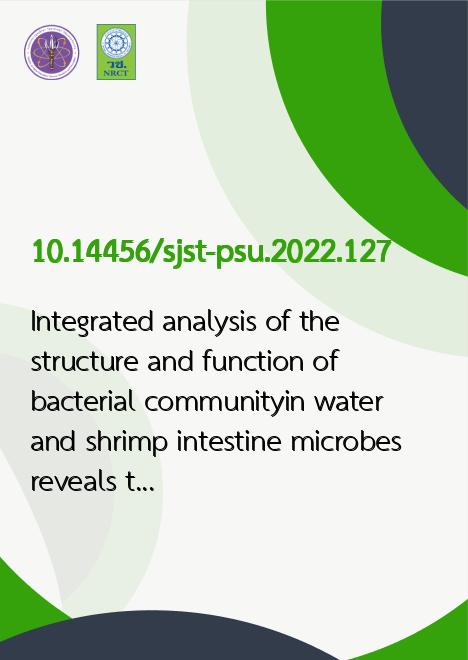
|
Integrated analysis of the structure and function of bacterial communityin water and shrimp intestine microbes reveals their interaction |
|---|---|
| รหัสดีโอไอ | |
| Creator | 1. Xinhao Fan 2. Yinghui Chai 3. Xuying Jia 4. Wenli Zhou |
| Title | Integrated analysis of the structure and function of bacterial communityin water and shrimp intestine microbes reveals their interaction |
| Publisher | Research and Development Office, Prince of Songkla University |
| Publication Year | 2565 |
| Journal Title | Songklanakarin Journal of Science an Technology (SJST) |
| Journal Vol. | 44 |
| Journal No. | 4 |
| Page no. | 953-962 |
| Keyword | microbiome, bacterial community, intestine, public data, shrimp |
| URL Website | https://rdo.psu.ac.th/sjst/index.php |
| ISSN | 0125-3395 |
| Abstract | Shrimp is closely associated with different microbial populations of the gut and the environment, particularly of thewater. Despite significant microbiome research in shrimp, a direct relationship between the shrimp's gut microbiota and thehabitat environment remains unclear. The bacterial profiles of the shrimp intestine and its aqueous environment were comparedby compiling data from earlier research to characterize the dynamic interaction between shrimp and habitat. According to theintegrated analysis, shrimp, water, and sediment all had significant operational taxonomic units (OTUs), with shrimp intestinehaving less OTUs and sediment having more. Furthermore, 66 biological activities were shown to be common in shrimp andwater bacteria, including nitrate reduction, methylotrophy, methanol oxidation, intracellular parasites, human infectiousdiarrhoea, fermentation, and others. These mechanisms might represent the primary bacterial processes related with intestinefunction, revealing new information on shrimp and water ecology. Although the relative abundances in the bacterial compositionwere different in shrimp intestine, water and sediment, the bacterial communities were almost similar, indicating the closeinteraction between host and the environment in microbiome. Notably, the significant distribution of disease-related pathogensincluding Vibrio and Flavobacterium in shrimp intestine and habitat water provided valuable information for disease predictionand shrimp health management in the aquaculture industry. In summary, many common microbes and bacterial processes thatoccur in the shrimp intestine and surrounding environment were revealed, and further functional analysis might help to modulatethese processes to promote shrimp development and health. |
